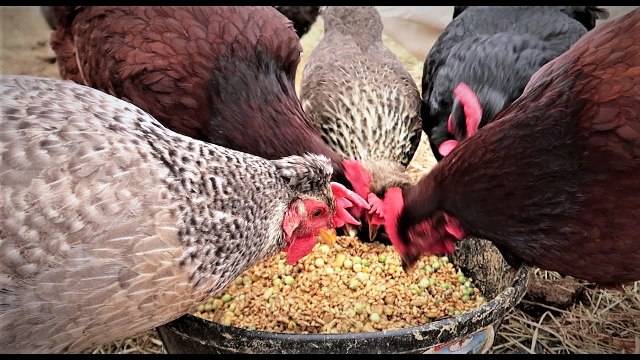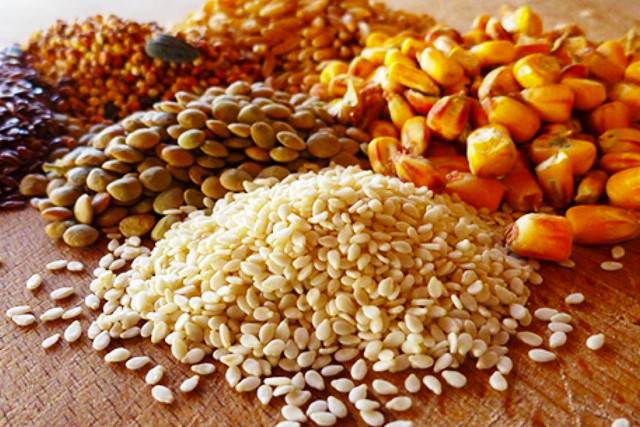
Feeding is one of the most important parts of poultry farming. Proper or balanced feeding will not only keep your chickens protected from various diseases but will also improve their productivity. Chickens may eat almost anything they get which can be harmful to them hence it is you who have to understand as to what is right for your chickens and what is wrong...
Profitability in poultry farming generally depends on 3 important factors:
-
a good breed
-
a balanced diet
-
efficient management
Moreover, the feed represents about 70 percent of the total cost of egg production and 55 percent of the cost of broiler production. Hence we can say efficiency in feeding is one of the key factors for successful poultry production.
Essential nutrients in the feed:
The poultry diet must have all essential nutrients like - energy, protein, vitamins, minerals, and the right quantity of water.
1. Energy
Carbohydrates and fats are the key nutrient sources of energy that are required by the chickens. The nutritional energy consumed by the chicken can be used to supply energy for various body functions or be converted into fat stored in the body or given out in some form of a product.
The chicken gets the required energy from the ingested feed. But, the whole of the energy present in the feed is not available to them. Also, it has been calculated that the net energy value of the diet of the chicken ranges between 70to 90 percent of the total energy.
You can completely replace the carbohydrates in the diet of chicken with fats, but the growth rate goes down significantly. But, fat utilization is very efficient in the chicken and growing fowl should be fed with diets having 12 percent fat without any effect on the digestibility of the food. Only linoleic acid is a vital nutrient in the diet of a chicken.
2. Protein
Proteins are the most important constituents of the soft tissue in the animal body. They are required for growth, egg production, and repair of wear and tear of tissues. All the proteins are made up of amino acids.
High-quality dietary protein ought to supply all the essential amino acids in the same proportion in which they occur in the body protein. In addition, the dietary protein should have a high digestibility.
Amino acids that are not used for protein synthesis by the body do not go to waste as food, as they are converted to an energy source. On the other hand, certain proteins of plant origin are not good for the chicken. Take, for instance, the proteins of raw soybean and various pulses contain certain harmful substances which cause growth depression in young chicken.
3. Vitamins
Vitamins are natural substances required by the body in small amounts for normal growth and production. Chicken also depend on food sources for vitamins requirement.
The following vitamins must be included in the diet of all birds: Vitamin A, Vitamin D3, Thiamine Riboflavin, Pentothenic acid, Nicotinic acid, Biotin, Vitamin B12, Alpha-tocopherol, Choline
Vitamin C is not necessary for the diet because, in normal conditions, the body's synthesis of this vitamin is sufficient to meet their requirements. But, under strain conditions, chickens are not able to synthesize optimum amounts and here, ascorbic acid supplemented diets prove helpful. Vitamin C can also increase the hatchability of eggs during the summer months.
4. Minerals
A chicken needs at least 13 minerals for proper growth, nourishment, and production. These minerals include sodium, calcium, phosphorus, potassium, chlorine, magnesium, zinc, iron, copper, manganese, molybdenum, selenium, and iodine. Growing chicken makes use of most of the calcium for the formation of the skeletal system.

5. Water
It is important to know that animals can bear a loss of 98 percent body fat, 50 percent body protein but not more than 20 percent body water. A young fowl will drink water at about 20 percent of its body weight.
Hens usually consume about 14 percent of their body weight. Also, water constitutes about 85 percent of the bodyweight of the chicks and 60 percent of the mature fowls. Egg also constitutes 60 percent of its weight as water. Hence, if the chickens are left without water or given only a limited quantity, it will have an adverse effect on their growth rate and production.
1. Maize
Maize is one of the most abundantly used grains in poultry because of its palatability and high energy content. The yellow maize variety is a rich source of carotene and manthophyll, a pigment deposited in broilers and egg yolk. Maize also contains a good amount of starch, but little fiber, some proteins, and ample vitamin A.
2. Oats
In comparison to maize and wheat, oats have a higher fiber content but a lower energy value. Oats can be utilized as a low-energy feed and broiler breeder replacement, accounting for up to 10% to 20% of the diet. Because of the fiber and manganese content, using oats in the diet minimizes the likelihood of cannibalism, feather picking, and hock diseases.
3. Sorghum
Sorghum is quite rich in protein as compared to maize but has low energy content. Light yellow-colored sorghum grains are generally preferred in the case of domestic chicken.
4. Other millets
Coarse grains such as pearl millet and ragi are usually fed to the poultry alone or mixed with other grains, as it is easily available in plenty and at a comparatively cheaper price. It may have traces of hydrocyanic acid that can be harmful depending upon the individual susceptibility. Therefore it is not advised to use them in poultry feed on a huge scale, though it can be given to the village chickens by spreading them on the ground.
5. Wheat and wheat bran
Wheat has a better feeding value if compared to oats and barley. It is highly palatable, digestible and a good source of B-complex vitamins. Broken wheat, a by-product of wheat flour mill can be used, even up to a level of 50 percent in the diet of the broilers. Wheat bran is the coarse outer covering of the wheat kernel and an excellent source of manganese, iron, and good source of riboflavin, pantothenic acid, choline, niacin, and thiamine.

6. Groundnut cake
It is one of the richest vegetable protein concentrates available and highly appetizing. It is low in certain essential amino acids like lysine, methionine, and cystine but high in arginine.
7. Soybean cake
It is a great source of vegetable protein and is rich in lysine 1 but deficient in methionine. It can be used for up to 40 percent of the poultry ration. It has an anti-nutritional factor known as antitrypsin in the meal.
8. Blood meal
It is an animal protein source that contains high lysine content. The amino-acid composition of blood meals is imbalanced, unpalatable and their digestibility is poor. Because of these reasons, blood meal is used at a low level - just 1 to 2 percent.
Apart from all the above-mentioned items, there are plenty of other things that can also be given to the chickens depending upon their age. But the only thing to be kept in mind is the right amount of that feed.
Feeding Management
Feeding of chickens must be done properly and systematically. Here are two things that you need to consider for this:
1. Quantity to be fed
The right quantity of diet to be fed depends upon the age groups of poultry. For chicks up to 2 weeks, you must give finely broken rice or other small grains or bread crumbs. Buttermilk or skimmed milk should be given for drinking.
After 2 weeks, the quantity of chick feed must be increased. After 6 weeks, you can give them a wet mash along with moist, well-chopped greens like Lucern. And after 8 weeks, the chick mash must be replaced by grower mash that is enriched with vitamins and minerals including all the essential nutrients.
After a 15-18th week, you must provide plenty of well-chopped greens and water. If you feed them with pellets instead of mash, it will prove more economical and neat.
2. Time of feeding
Regularity in the feeding is also important as your chickens will soon learn and expect to have their food on time. The chicks must be fed 5 - 6 times a day in small quantities for up to 8 weeks of age.
For backyard units, fowl should be let out early in the morning after giving them clean drinking water. Afterward, give them some grains - about 15 grams per bird. Then give them some greens or vegetable pruning mixed with mash in the afternoon. In the evening, provide them some more grains.
To conclude we can say that a poultry farmer's success mainly depends on the type, source, and quality of feed, which accounts for 70 percent of the total cost of egg production and 55 percent of the cost of broiler production.
I would like to mention that the article has been prepared with the guidance and support of Dr. K.T. Chandy of Agricultural & Environmental Education who is the author of several books.
If you want to start a successful poultry farming business then do visit the website of Krishi Jagran.

















